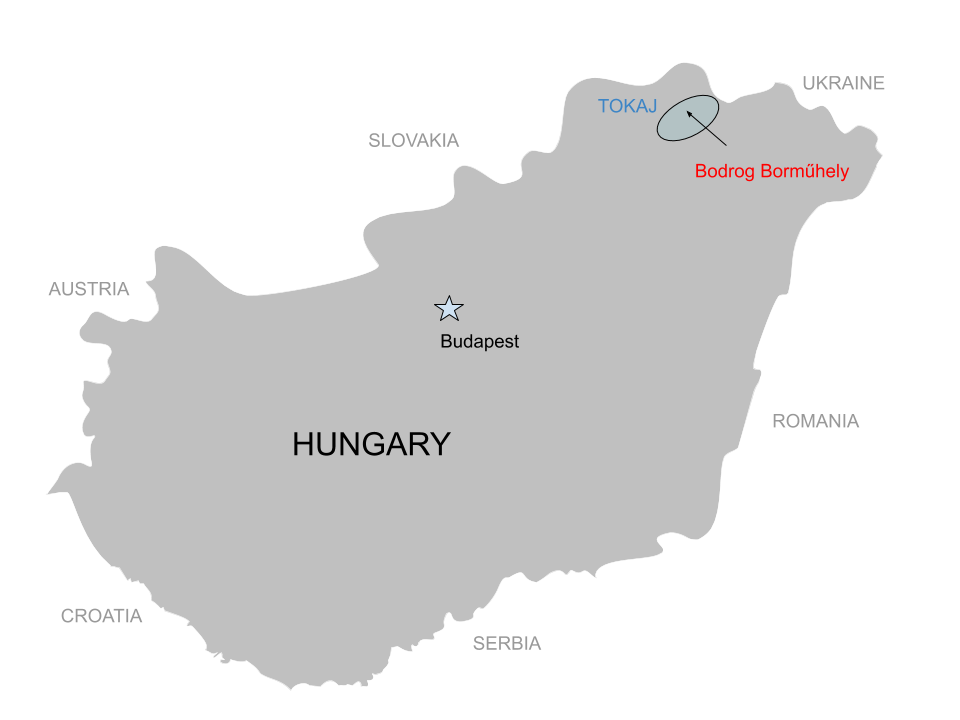2016 Bodrog Borműhely Furmint Lapis
Tokaj, Hungary

In North-Eastern Hungary, Tokaji - Hegyalja warranted the world’s first appellation system over 100 years before Bordeaux. For nearly 400 years, it has served as a diplomatic tool to court foreign powers, inspired countless artists and philosophers, and has become so ingrained in Hungarian identity that it’s part of their National Anthem. One of the key features of life and history in the region is the Bodrog River. It runs from the village of Sárospatak in the north east all to the way down to Tokaj Hill in the south. The name „Bodrog” dates back to the first Magyar conquest and the very first kings of Hungary. It’s also responsible for the moisture that along with a unique confluence of grapes and terroir, makes Botrytis so prevelent. Today, only 20+ years after the re-establishment of private and family wineries, Hungary is in the midst of a wine renaissance. Bodrog Borműhely, or “Bodrog wine(bor) workshop” started by János Hajduz and Krisztián Farkas is emblematic of this new era. By maintaining tiny parcels of vineyards in historically great sites they are making pure, modern, yet classically inspired dry wines. Knowing when to pick and where, avoiding Botrytis, and then fermenting with native yeasts in local oak barrel are the means to this end.
VINEYARDS
The Halas (Fish) vineyard is just southwest of Lapis near the town of Bodrogkeresztúr. The vineyard is covered with a think layer of Nyirok — a rich reddish clay unique to Tokaji over a base of hardened rhyolite (volcanic) rock. The microclimate is relatively warm compared to other parts of the appellation, but the vines are 40-50 years old and well adjusted. In addition to Furmint, there is also a small plot of Pinot Noir which will soon be ready to make wine for the very first time. The Lapis Vineyard is near the town of Bodrogkeresztúr and looks down onto the Bodrog River and its floodplains. Despite being near to all of this moisture, Botrytis only hits certain parts of the vineyard. The 0.7 ha that they farm is 155m up and in a breezy spot making dry wines possible. The soil is a mixture of rhyolite with strong brown clay soil and tufa. If there were to be reclassification of the Tokaji vineyards, this would be a strong contender for a Great Growth.
WINE MAKING
All wines are hand picked and sorted in the vineyard and then again in the winery. After settling for at least a day after crush, wines are barreled down into local Szerednye Oak Barrels (3-4 years old) and left to ferment on their own yeasts. The Dry Tokaj is 100% stainless steel. After regular batonnage, full malolactic fermentation and 9 months of aging sur lie, all wines are gently filtered and sulfured before bottling.
NOTES & PAIRINGS
Although fermented and aged in Hungarian oak, it’s mostly the breathing nature of the wood and a little texture that’s imparted. The mixture of clay and volcanic tufa also lends a mineral richness that makes this the most creamy of the Bodrog wines. Furmint from the Lapis vineyard is to Tokaj what Chenin Blanc planted in the Montlouis-sur-Loire is to the Loire Valley. For a furmint with very little age on it, the wine drinks incredibly well right now. Sweet aromatics, spicy on the palate, and a weighty texture balanced with enough acidity for pork, umami like sauces, and anything smokey.
ANALYTICS & PRONUNCIATION
PRODUCER: Bodrog Borműhely
APPELLATION: Tokaj (Toke-Eye)
VINTAGE: 2016
GRAPE COMPOSITION: 100% Furmint
CLIMATE: Cool Continental
SOILS: Rhyolite with strong brown clay soil and tufa
EXPOSURE: Southern
MACERATION & AGING: 220L Szerednyei Oak Barrel (Hungarian)
ALCOHOL: 13%
RESIDUAL SUGAR: 2.8 g/l
ACIDITY: 5.9 g/l
